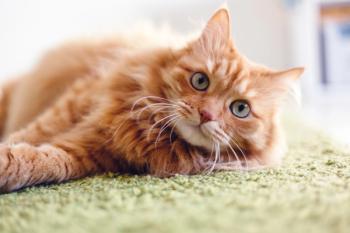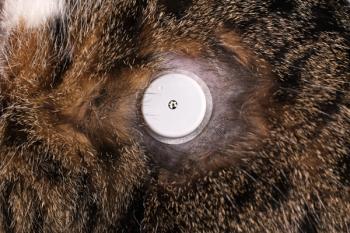
Managing the hyperthyroid cat with renal disease (Proceedings)
Recognizing hypertension in cats with hyperthyroidism is not always simple. In normal cats, measurement of blood pressure is fairly reliable, whether using oscillometry or Doppler ultrasonography.1 Both correlate well with intra-arterial measurements.2 The "white coat effect", however, is not always recognized in feline medicine, and this effect may well be more pronounced in cats with hyperthyroidism than in less stressed normal cats.
Hypertension in feline hyperthyroidism
Recognizing hypertension in cats with hyperthyroidism is not always simple. In normal cats, measurement of blood pressure is fairly reliable, whether using oscillometry or Doppler ultrasonography.1 Both correlate well with intra-arterial measurements.2 The "white coat effect", however, is not always recognized in feline medicine, and this effect may well be more pronounced in cats with hyperthyroidism than in less stressed normal cats. Initially, the prevalence of hypertension in cats with hyperthyroidism was considered very high. An early publication showed a prevalence of 87%.3 In that study the definition of hypertension may have been unrealistically low, but the study was well-controlled, with hyperthyroid cats being compared to groups of both normal cats and cats with chronic renal failure...
Later reports showed lower prevalence rates (between 5% and 20%) of hypertension in cats with hyperthyroidism.4,5 Stepien et al. showed a significant "white coat effect" in cats with hyperthyroidism, with no decrease in blood pressure after treatment. Syme and Elliot, showed a significant increase in the occurrence of hypertension in cats after treatment for hyperthyroidism. Hypertension occurs rarely in human hyperthyroidism, and on rare occasions when hypertension is associated with thyrotoxicosis, the hypertension is usually systolic only. Thyroid hormone causes a pronounced decrease in peripheral vascular resistance. Hemodynamic effects of thyrotoxicosis include increased heart rate and increased stroke volume. It has been proposed that increased heart rate causes a summation of pressure in peripheral arteries with the pressure from systole, resulting in overall systolic hypertension.6 Whether or not this also occurs in cats with hyperthyroidism is unknown, but these cats have also been reported to have diastolic hypertension. This may be related to underlying kidney disease. Furthermore, beta adrenergic blockers are effective in treatment of systolic hypertension when it occurs in hyperthyroid human patients, but the effect of atenolol on hypertension is cats with hyperthyroidism is inconsistent.7 It is difficult to tell if hyperthyroidism really does cause hypertension in cats. There is an association between the two, but a cause and effect has not been established. If hyperthyroidism is a significant cause of hypertension, it may not be as common a cause as some clinicians might believe. In one study, only 5 of 30 cats with hypertension were diagnosed with hyperthyroidism.8 In a study of cats with hypertensive retinopathy, only 5 of 69 cats were hyperthyroid.9
Regardless of the debate over hypertension in cats with hyperthyroidism, treatment of hypertension is recommended because of the risk of organ damage.2 Drugs used to treat hypertension in cats fall include angiotensin-converting enzyme (ACE) inhibitors, calcium-channel antagonists, and beta adrenergic antagonists. Treatment of hypertension in cats is reviewed elsewhere.2
Hyperthyroidism and the kidney
Treatment of hyperthyroidism can have deleterious effects on renal function in cats, likely because hyperthyroidism may mask pre-existing underlying chronic renal failure.10-13 Treatment of hyperthyroidism using any modality causes a consistent, and sometimes disastrous, drop in glomerular filtration rate (GFR). It may be unwise to treat hyperthyroidism in a cat with questionable renal function. Especially in cats with impaired renal function, the use of methimazole as a first-line treatment makes sense because it may be reversible. In one study, we showed a consistent decrease in GFR upon methimazole treatment in hyperthyroid cats, and we were also observed a reversal of this effect when methimazole therapy was stopped.13 If a cat treated with methimazole experiences a severe drop in GFR and develops overt renal failure, the clinician must begin the difficult course of balancing hyperthyroidism and its effects against the effects of renal failure. In some cases, hyperthyroidism cannot be treated at all, and the clinician must manage weight loss, hypertension, tachycardia, and cardiac disease. In cases in which methimazole does not cause overt renal failure, owners and veterinarians can probably feel more comfortable about pursuing a more permanent treatment such as radioiodine or surgical thyroidectomy.
Clinicians treating cats in overt renal failure after treatment for hyperthyroidism often consider thyroid hormone supplementation as a means of restoring renal blood flow and increasing GFR. In an unpublished study, we followed cats treated with thyroxine following post-treatment renal failure, and we found discouraging results. Treatment with thyroxine resulted in an increase in the concentration of T4 in the serum, as expected, but there was no significant decrease in BUN or creatinine. Body weight and body condition remained unchanged as well. Based on these very preliminary results, it would seem much better to prevent post-treatment renal failure than to attempt treatment with thyroid hormone supplementation once renal failure becomes evident.
Methimazole trials
There are few published data to guide decisions concerning methimazole trials. Veterinarians, general practitioners and specialists alike, commonly recommend methimazole trials only for cats with questionable renal function. There is a commonly held belief that cats with well-concentrated urine (urine specific gravity > 1.035) have adequate renal function and do not run a significant risk of post-treatment renal insufficiency and that methimazole trials are not needed in these cats.14 Results of our studies, however, do not support this opinion. We studied 20 hyperthyroid cats developing overt renal insufficiency within 6 months of radioiodine treatment in our hospital, and compared results with 19 post-treatment cats in which overt renal failure did not develop.15 10 (50%) had urine specific gravity measurements greater than 1.035. Three of those cats had urine specific gravity measurements above 1.050. We suspect, therefore, that urine specific gravity should not be used as a predictor of post-treatment renal status in hyperthyroid cats, and that a methimazole trial should be recommended for any hyperthyroid cat that can tolerate the drug.
The best length of time for a methimazole trial is also debatable. Studies in which GFR has been measured in cats treated for hyperthyroidism have typically examined renal function before and 30 days after treatment. A recent study, however, showed that the majority of the decline in GFR following treatment of hyperthyroidism typically occurs in the first month.16 Evidence suggests that 30 days is a reasonable time for a methimazole trial. A common mistake, however, is failure to recheck serum thyroid hormone concentrations during the trial. Because the half-life of T4 in the cat is less than 8 hours, it makes sense to recheck cats one week after starting a trial. If the T4 is not in the lower half of the normal range (optimal for hyperthyroidism control), the dose is increased and the one-month period is started again. Often the dose of methimazole needs to be adjusted to achieve euthyroidism, and the goal is to have euthyroidism for a month, not just methimazole for a month. Because of the danger of developing other side effects to methimazole ( eg. vomiting, hepatopathy, blood dyscrasia) cats should be re-evaluated at 2-week intervals while on a methimazole trial.
References
Jepson RE, Elliott J, Brodbelt D, Syme HM. Effect of control of systolic blood pressure on survival in cats with systemic hypertension. J Vet Intern Med. 2007;21:402-9.
Brown S, Atkins C, Bagley R, Carr A, Cowgill L, Davidson M, Egner B, Elliott J, Henik R, Labato M, Littman M, Polzin D, Ross L, Snyder P, Stepien R; American College of Veterinary Internal Medicine.Guidelines for the identification, evaluation, and management of systemic hypertension in dogs and cats. J Vet Intern Med. 2007;21:542-58.
Kobayashi DL, Peterson ME, Graves TK, Lesser M, Nichols CE. Hypertension in cats with chronic renal failure or hyperthyroidism. J Vet Intern Med. 1990;4:58-62.
Stepien RL, Rapoport GS, Henik RA, Sartor LL, Wenholz L. Effect of measurement method on blood pressure findings in cats before and after treatment for hyperthyroidism. J Vet Intern Med 2003;17:754 (abstract).
Syme HM, Elliott J. The prevalence of hypertension in hyperthyroid cats at diagnosis and following treatment. J Vet Intern Med 2003;17:754-755 (abstract).
Biondi B, Palmieri EA, Lombardi G, Fazio S. Effects of thyroid hormone on cardiac function: the relative importance of heart rate, loading conditions, and myocardial contractility in the regulation of cardiac performance in human hyperthyroidism. J Clin Endocrinol Metab. 2002;87:968-74.
Henik RA, Stepien RL, Wenholz LJ, Dolson MK. Efficacy of atenolol as a single antihypertensive agent in hyperthyroid cats. J Feline Med Surg. 2008;10:577-82.
Elliott J, Barber PJ, Syme HM, Rawlings JM, Markwell PJ. Feline hypertension: clinical findings and response to antihypertensive treatment in 30 cases. J Small Anim Pract. 2001;42:122-9.
Maggio F, DeFrancesco TC, Atkins CE, Pizzirani S, Gilger BC, Davidson MG. Ocular lesions associated with systemic hypertension in cats: 69 cases (1985-1998). J Am Vet Med Assoc. 2000;217:695-702.
Graves TK, Olivier NB, Nachreiner RF, Kruger JM, Walshaw R, Stickle R. Changes in renal function associated with treatment of naturally-occurring hyperthyroidism in cats. Am J Vet Res 55:1745-1749, 1994.
DiBartola SP, Broome MR, Stein BS, et al. Effect of treatment of hyperthyroidism on renal function in cats. J Am Vet Med Assoc. 1996;208:875-878.
Adams WH, Daniel GB, Legendre AM, et al. Changes in renal function in cats following treatment of hyperthyroidism using 131I. Vet Radiol Ultrasound. 1997;38:231-238.
Becker TJ, Graves TK, Kruger JM, et al. Effects of methimazole on renal function in cats with hyperthyroidism. J Am Anim Hosp Assoc. 2000;36:215-223.
Garrett LD, The hyperthyroid cat. NAVC Clinician's Brief 2006;4:79-82.
Riensche MR, Graves TK, An investigation of predictors of renal failure following treatment of hyperthyroidism in cats, J Feline Med Surg 2008;10:160-166.
van Hoek IM, Peremans K, Vandermeulen E, et al. Effect of recombinant human thyroid stimulating hormone on serum thyroxin and thyroid scintigraphy in euthyroid cats. J Feline Med Surg. 2009;11:309-14.
Newsletter
From exam room tips to practice management insights, get trusted veterinary news delivered straight to your inbox—subscribe to dvm360.




